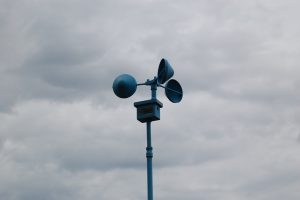
There seem to be new developments in Meteorology coming out every day. Faster computers and new computer models seem to give us and endless supply of information to look at. One thing that has not changed is the basic anemometer. Records of this device to measure the anemos (that’s Greek for wind) was developed in the 15th century, that’s close to 3 centuries before the science of Meteorology made any real significant progress in understanding the atmosphere. Over the years there have been different types anemometers developed and technology has helped put these devices literally in the palm of your hand, but the basic design remains the same.
Leon Battista Alberti is credited with designing the first anemometer in 1450. History also has records of Robert Hooke and the Mayans inventing similar devices and wind measuring towers in the following centuries. Interesting to note that the first 2 gentlemen were Architects, Alberti from Italy and Hooke from England. It was not until the 19th century that a physicist from the United Kingdom developed the first cup style anemometer. John Thomas Romney Robinson took the original design and improved with with cups and mechanical wheels that spin and different rates depending on the wind speed. The only minor change between his design and the one you see today is one less cups thanks to John Patterson in 1926, a physicist and meteorologist in Canada.
Other designs have come along that have advantages and disadvantages in different wind situations. Some anemometers can detect very small changes in wind speed which make them better and detecting turbulence. Acoustic anemometers determine the wind speed by measuring how an acoustic wave is modified inside a small cavity exposed to the wind. Small and able to withstand the elements, these sensors are ideal for remote locations such as wind turbines.
Even though the basic design remains the same, you can now hold these basic anemometers in the palm of your hand. A common type of hand held anemometer would be a vane design similar to a propeller you would see on a wind mill. Developed over a century ago you can now hold a similar device in the palm of your hand to measure the power of the wind.